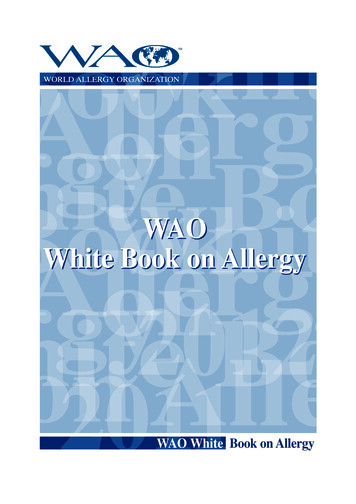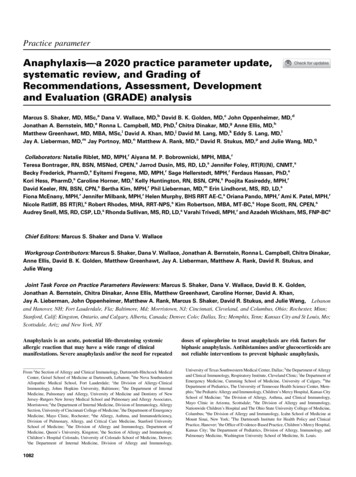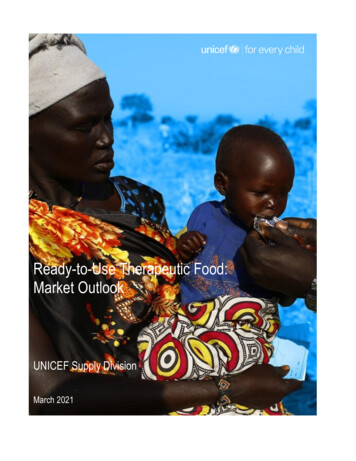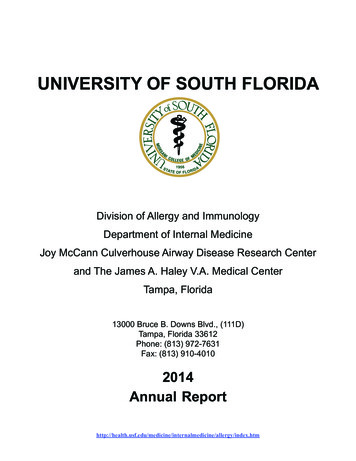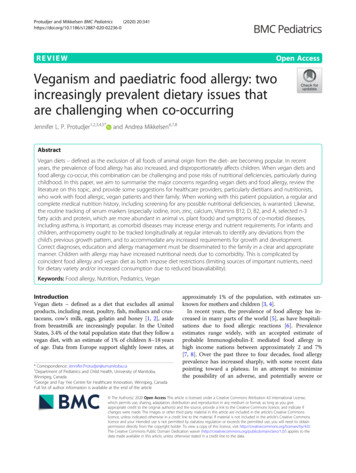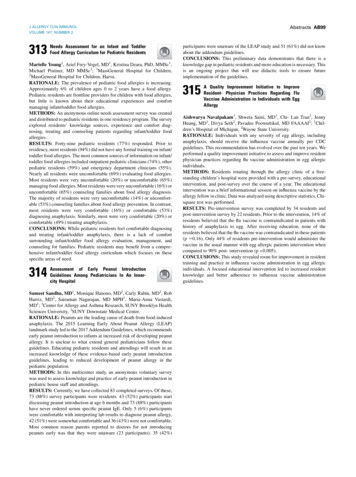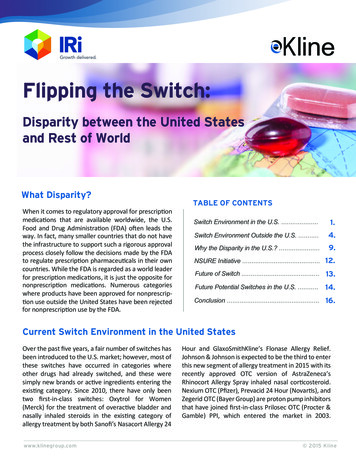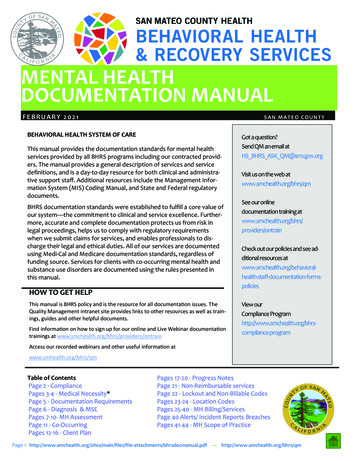
Transcription
Practice parameterPeanut allergy diagnosis: A 2020 practiceparameter update, systematic review, andGRADE analysisMatthew Greenhawt, MD, MBA, MSc,a Marcus Shaker, MD, MS,b Julie Wang, MD,c John J. Oppenheimer, MD,dScott Sicherer, MD,c Corinne Keet, MD, PhD,e Keri Swaggart, MLIS,f Matthew Rank, MD,g,h Jay M. Portnoy, MD,iJonathan Bernstein, MD,j Derek K. Chu, MD, PhD,k,l Chitra Dinakar, MD,m David Golden, MD,n Carolyn Horner, MD,oDavid M. Lang, MD,p Eddy S. Lang, MD,q David A. Khan, MD,r Jay Lieberman, MD,s David Stukus, MD,t andDana Wallace, MDuAurora, Colo; Lebanon, NH; New York, NY; Morristown, NJ; Baltimore, Md; Kansas City and St. Louis,Mo; Scottsdale and Phoenix, Ariz; Cincinnati, Cleveland, and Columbus, Ohio; Hamilton, Ontario, and Calgary, Alberta, Canada; Palo Alto,Calif; Dallas, Tex; Memphis, Tenn; and Fort Lauderdale, FlaGiven the burden of disease and the consequences of a diagnosisof peanut allergy, it is important that peanut allergy beaccurately diagnosed so that an appropriate treatment plan canbe developed. However, a test that indicates there is peanutsensitization present (eg, a ‘‘positive’’ test) is not alwaysassociated with clinical reactivity. This practice parameteraddresses the diagnosis of IgE-mediated peanut allergy, both inchildren and adults, as pertaining to 3 fundamental questions,and based on the systematic reviews and meta-analyses, makesrecommendations for the clinician who is evaluating a patientfor peanut allergy. These questions relate to when diagnostictests should be completed, which diagnostic tests to utilize, andthe utility (or lack thereof) of diagnostic testing to predict theseverity of a future allergic reaction to peanut. (J Allergy ClinImmunol 2020;146:1302-34.)Key words: Peanut allergy, diagnosis, practice parameter update,systematic review, GRADE analysis, Ara h 2, peanut components,skin prick testing, serologic IgE testing, likelihood ratio, evidenceto recommendation, meta-analysis, cost-effectiveness analysisEXECUTIVE SUMMARYIgE-mediated peanut allergy has an estimated prevalence ofbetween 0.2% and 4.5%, depending on geographic area of theworld and the methodology used for assessment. While theprevalence in the United States appears to have tripled in a recentFrom athe Section of Allergy and Immunology, Department of Pediatrics, Children’sHospital Colorado, University of Colorado School of Medicine, Aurora; bthe Sectionof Allergy and Immunology, Dartmouth-Hitchcock Medical Center, Dartmouth GeiselSchool of Medicine, Lebanon; cthe Division of Pediatric Allergy and Immunology,Department of Pediatrics, Icahn School of Medicine at Mount Sinai and the JaffeFood Allergy Institute, New York; dthe Department of Internal Medicine, New JerseyMedical School, Morristown; ethe Division of Pediatric Allergy and Immunology,Department of Pediatrics, and nthe Department of Allergy-Clinical Immunology,Department of Medicine, Johns Hopkins School of Medicine, Baltimore; fthe LibraryServices, Children’s Mercy Hospital, Kansas City; gthe Division of Allergy, Asthma,and Clinical Immunology, Mayo Clinic, Scottsdale; hthe Division of Pulmonology,Phoenix Children’s Hospital; ithe Division of Allergy, Asthma, & Immunology,Department of Pediatrics, Children’s Mercy Hospital, Kansas City; jthe Division ofImmunology, Department of Internal Medicine, University of Cincinnati; kthe1302Abbreviations usedAAAAI: American Academy of Allergy, Asthma, and ImmunologyACAAI: American College of Asthma, Allergy, and ImmunologyAMSTAR: Assessing the Methodological Quality of SystematicReviewsFPIES: Food protein induced enterocolitis syndromeGRADE: Grading of Recommendations, Assessment, Development, and EvaluationJTFPP: Joint Task Force on Practice ParametersKUA: Kilo allergen unitNIAID: National Institutes of Allergy and Infectious DiseaseOFC: Oral food challengePICO: Population, intervention, comparator, and outcomePPV: Positive predictive valuePRISMA: Preferred Reporting Items for Systematic Reviews andMeta-AnalysessIgE: Serum-specific IgESPT: Skin prick test10-year period, in the United Kingdom, the prevalence seems tohave plateaued over a similar period, denoting regional heterogeneity in such trends. Peanut allergy is associated with substantial economic and psychologic burden on families that isassociated with poor quality of life and high anxiety related tothe potential consequences of their child having a severe allergicreaction. Peanut allergy is often a severe and usually a lifelongallergy that is a leading cause of food-related anaphylaxis. OneDepartment of Health Research Methods, Evidence & Impact, Department of Medicine, McMaster University, Hamilton; lThe Research Institute of St. Joe’s Hamilton;mthe Division of Allergy and Asthma, Department of Pediatrics, Stanford UniversitySchool of Medicine, Palo Alto; othe Division of Allergy, Immunology, and PulmonaryMedicine, Washington University School of Medicine, St Louis; pthe Department ofAllergy and Clinical Immunology, Cleveland Clinic; qthe Department of EmergencyMedicine, Cumming School of Medicine, University of Calgary; rthe Division of Allergy & Immunology, Department of Medicine, University of Texas SouthwesternMedical Center, Dallas; sthe Division of Allergy and Immunology, Department of Pediatrics, The University of Tennessee, Memphis; tthe Division of Allergy and Immunology, Department of Pediatrics, The Ohio State University College of Medicine,Columbus; and uthe Nova Southeastern University College of Allopathic Medicine,Fort Lauderdale.
J ALLERGY CLIN IMMUNOLVOLUME 146, NUMBER 6GREENHAWT ET AL 1303peanut allergy treatment has been approved by the US Food andDrug Administration, and several other emerging treatments areapproaching consideration for US Food and Drug Administrationapproval. However, presently peanut allergy is managed throughpeanut avoidance and by carrying emergency medication such asautoinjectable epinephrine to treat symptoms that may arise fromunintended ingestion.Given this burden of disease and the consequences ofdiagnosis, it is important that peanut allergy be accuratelydiagnosed so that an appropriate treatment plan can be developed.However, a positive peanut test result is not always associatedwith clinical reactivity. This practice parameter addresses thediagnosis of IgE-mediated peanut allergy, both in children andadults, as pertaining to 3 fundamental questions (see Box 1). Thisparameter exclusively discusses IgE-mediated peanut allergy andall references herein pertain to IgE-mediated food allergy to peanut only and not to peanut as a potential trigger in eosinophilicesophagitis or non-IgE-mediated food allergy such as food protein induced enterocolitis syndrome (FPIES). Similarly, emergingtechnologies such as basophil activation testing were also notincluded in this analysis.Diagnostic testing for peanut allergy is used to help make adiagnosis where there is suspicion of a peanut allergy based on theclinical history. Failure to make a correct diagnosis can result ineither unnecessary avoidance in a nonallergic person, or erroneous guidance that the patient can safely ingest peanut ad libitumwhen there is in fact an allergy—both of which are problematicsituations. A correct diagnosis facilitates peanut avoidance andcounseling when the patient is at risk of potential lifethreatening complications of peanut allergy and therefore isadvised to carry epinephrine for use in case of symptomatic accidental ingestion. Alternatively, exclusion of peanut allergy allowspeanut to be incorporated into the diet without concern, eliminating the burden of precautions and fear. Changes in peanutsensitization levels over time, compared with baseline, may beassociated with whether the individual with allergy is likely tobe outgrowing their peanut allergy. Although previous researchin patients with established peanut allergy reported clinical diagnostic cutoff points for 95% chance of reaction and for 50%chance of reaction to oral food challenge (OFC), these are notnecessarily predictive of clinical outcomes in all settings and patients, as they are highly dependent on the baseline prevalence ofDisclosure of potential conflict of interest: The Joint Task Force on Practice Parameters(JTFPP) members’ and work group members’ conflict of interest disclosure forms canbe found at www.allergyparameters.org. Matthew Greenhawt has received financialsupport from Aquestive, Aimmune, Merck, Allergenis, Allergy Therapeutics, SanofiGenzyme, Genentech, GlaxoSmithKline, Merck, Aravax, Prota, Before Brands, theInstitute for Clinical and Economic Review, American College of Asthma, Allergy,and Immunology, DBV Technologies, and Intrommune; is supported by the Agencyof Healthcare Research and Quality; has served on the advisory board of InternationalFood Protein Induced Enterocolitis Syndrome Association, the Asthma and AllergyFoundation of America, and the National Peanut Board; and is Associate Editor ofthe Annals of Allergy, Asthma, and Immunology. Marcus Shaker is a member of theJoint Task Force on Allergy Practice Parameters; has a family member who is chiefexecutive officer of Altrix Medical; and serves on the Editorial Board of the Journalof Food Allergy and the Annals of Allergy, Asthma, and Immunology. Julie Wang hasreceived financial support from ALK-Abell o, Regeneron, DBV Technologies, andAimmune; is an UpToDate author; serves on the Executive Committee of the AmericanAcademy of Pediatrics Section on Allergy and Immunology; and serves as Vice Chairof the American Academy of Allergy, Asthma, and Immunology (AAAAI) Anaphylaxis, Dermatitis, Drug Allergy Interest Section. John J. Oppenheimer has receivedfinancial support from DBV Technologies, TEVA, GlaxoSmithKline Adjudication/Data Safety Monitoring Board, AstraZeneca, Novartis, and Sanofi; and is AssociateEditor of the Annals of Allergy, Asthma, and Immunology and AllergyWatch, an American Board of Internal Medicine (ABIM) Council Member, and American Board of Allergy and Immunology Liaison to the ABIM, UpToDate Reviewer, American Collegeof Chest Physicians Cough Guideline Committee Member, and WebMD Editor. ScottSicherer has received financial support from Food Allergy Research and EducationClinical Center, John Hopkins University Press, HAL Allergy Group, AAAAI, UpToDate, and National Institutes of Allergy and Infectious Disease; and is a MedicalAdvisor at International Food Protein Induced Enterocolitis Syndrome Associationand member of the Executive Committee at the American Academy of Pediatrics. Corinne Keet received royalties from UpToDate; is an Associate Editor for the Journal ofAllergy and Clinical Immunology; and is a Board Member for the American Board ofAllergy and Immunology. Matthew Rank has received financial support from theAmerican College of Asthma, Allergy, and Immunology (ACAAI), National Institutesof Health, and Levin Family Foundation; has served as Chair of the AAAAI Health Education Delivery and Quality (HEDQ) Interest Section; and is Research Director of thePhoenix Children’s Hospital Breathmobile. Jay M. Portnoy has received financial support from Thermo Fisher Scientific, Kaleo, TEVA, Novartis, Hycor, and BoehringerIngelheim. Jonathan Bernstein has received financial support from Sanofi Regeneron,AstraZeneca, Merck, Optinose, Takeda, CSL Behring, Biocryst, Pharming, the National Institutes of Health, Taylor and Francis, and INEOS; is Editor-in-Chief of theJournal of Asthma, INEOS medical immunosurveillance director, Vice Chair andLectureship Chair of the AAAAI Foundation, chairman of Allergists for Israel(AFI), ACAAI Asthma Chair, Scientific Chair, and Young Investigator Award Chair;and serves on the Board of Directors and Scientific Committee of Interasma. DerekK. Chu is a CAAIF-CSACI-AllerGen Emerging Clinician-Scientist Research Fellow;and is supported by the Canadian Allergy, Asthma and Immunology Foundation(CAAIF), the Canadian Society of Allergy and Clinical Immunology (CSACI), andAllerGen NCE Inc. (the Allergy, Genes and Environment Network). Chitra Dinakarhas received financial support from Propeller Health, ACAAI (stipend for EditorialBoard of AllergyWatch), and the American Association of Allergists of Indian Origin;serves on the Board of Directors of the AAAAI and on the Medical Advisory Board ofFood Equity Initiative; and is Assistant Editor of AllergyWatch. David Golden hasreceived financial support from Aquestive, Sandoz, ALK-Abell o, Genentech,Stallergenes-Greer, and UpToDate. Carolyn Horner has served as Committee Chairfor the American Academy of Allergy, Asthma, and Asthma Diagnosis and TreatmentInterest Section, Interest Section Coordinating Committee, and In-Training ExamCoordinating Committee. David M. Lang is on the Editorial Board for Allergy andAsthma Proceedings, Topic Editor for DynaMed, Associate Editor for Journal ofAsthma, and Delegate to National Quality Forum representing the AAAAI. DavidA. Khan has received financial support from UpToDate and Aimmune; serves on theBoard of Directors of the AAAAI; as ACAAI (Chair of Literature Review, as CoChair of Conjoint Board Review, and as Texas Allergy, Asthma, and Immunology Society Chair of Meetings Committee; and is Associate Editor of the Journal of Allergyand Clinical Immunology In Practice. Jay Lieberman has received financial supportfrom the ACAAI, Aquestive, Aimmune, DBV Technologies, Biotest Pharma, and Regeneron; and is Associate Editor of the Annals of Allergy, Asthma, and Immunology,Vice Chair for the ACAAI Food Allergy Committee, and Medical Director for FoodAllergy Alliance of the MidSouth. David Stukus has received financial support fromAimmune, Before Brands, Abbott Nutrition, the American Academy of Pediatrics,and ACAAI; and has served as Committee Chair for the AAAAI and ACAAI. DanaWallace has received financial support from Mylan, Kaleo, Optinose, ALK-Abell o,Bryan, and Sanofi. The rest of the authors declare that they have no relevant conflictsof interest.Reprints: Joint Task Force on Practice Parameters Liaison: Peris Flagg (American Academy of Allergy, Asthma, and Immunology, 555 E. Wells Street, Suite 1100, Milwaukee, WI 53202. E-mail: pflagg@aaaai.org); JTFPP.allergy@gmail.com.Previously published practice parameters of the JTFPP for allergy and immunology arealso available at http://www.allergyparameters.org, http://www.AAAAI.org, andhttp://www.ACAAI.org.Received for publication April 21, 2020; revised July 14, 2020; accepted for publicationJuly 17, 2020.Available online August 15, 2020.Corresponding author: Matthew Greenhawt, MD, MBA, MSc, Section of Allergy andImmunology, Food Challenge and Research Unit, Children’s Hospital Colorado, University of Colorado School of Medicine, 13123 E. 16th Avenue, Aurora, CO 80045.E-mail: Matthew.Greenhawt@childrenscolorado.org.The CrossMark symbol notifies online readers when updates have been made to thearticle such as errata or minor corrections0091-6749/ 36.00Ó 2020 American Academy of Allergy, Asthma & 31
1304 GREENHAWT ET ALJ ALLERGY CLIN IMMUNOLDECEMBER 2020Box 1. GRADE questions evaluated in this practice parameterPICO questions: GRADE analysis of diagnostic testing in the diagnosis of peanut allergy1. Should diagnostic testing for peanut allergy be performed in adults and children with a history of suspected peanut allergy whoare requesting evaluation for peanut allergy?2, A. In the patient presenting for evaluation of suspected peanut allergy, which of the 3 tests—SPT, sIgE to whole peanut, or Ara h 2—would provide the highest diagnostic accuracy as determined by the more optimal positive/negative likelihood ratio?2, B. In a patient presenting for evaluation of suspected peanut allergy, does testing for peanut components in addition to either SPTor sIgE to whole peanut increase the diagnostic accuracy?3. In the patient presenting for evaluation of suspected peanut allergy, can the results of a diagnostic test be used to predict theseverity of a future allergic reaction?peanut allergy in the particular population studied, which mayvary. This practice parameter uses likelihood ratios as the mainstatistic in this analysis, given this metric is not dependent on apopulation prevalence of disease, and is more adaptable to individual clinical settings.The expert panel developed the key PICO (population,intervention, comparator, and outcome) questions to be addressed, and after a systematic review of the literature ( 1300references searched), a meta-analysis of the evidence, and aGRADE (Grading of Recommendations, Assessment, Development and Evaluation) analysis (a well-established methodologyfor developing evidence-based guidelines) of the results (seeTable I) made its recommendations. All the recommendationswere conditional in strength, with low or very low certainty of evidence. Thresholds for detection of sensitization were at 3 mm forskin prick test (SPT), and 0.35 KUA/L (KUA 5 kilo allergen unit)for both whole peanut serum-specific IgE (sIgE) and componentspecific peanut sIgE, based on the most widely reported levelsevaluated in the literature. Additional cutoffs were considered,but their use would have posed a significant limitation to the analysis, given very limited study numbers reporting these values.Extensive sensitivity analysis was performed to confirm theresults.The expert panel suggested that diagnostic testing for peanutallergy be used in patients with a high pretest probability ofpeanut allergy, or prior to an OFC for patients with moderatepretest probability of peanut allergy, as a preference-sensitivechoice, but discourages testing in patients with a low or very lowpretest probability of peanut allergy. If a single diagnostic testwere to be used, testing for the Ara h 2 component would providethe most diagnostic accuracy, as determined by the more optimalpositive/negative likelihood ratio among the presently availabletesting options. However, this is contingent on Ara h 2 componenttesting becoming more commonly available as a stand-alone test,as opposed to being primarily offered by laboratories as a panelwith other peanut components. The literature search did notprovide patient-level data to determine the value of testing forpeanut components in addition to SPT or sIgE to whole peanut toincrease diagnostic accuracy, including isolated Ara h 2 in thatcontext. The clinician should not use the results of a SPT, sIgE towhole peanut extract, or sIgE to peanut components to determinean allergy phenotype or to predict the severity of a future reaction(eg, will the patient have anaphylaxis to peanut). An additionalsupplemental cost-effectiveness analysis of the potential testingoptions presented in the Online Repository (available at www.jacionline.org) confirms use of Ara h 2 as the optimal choicewhen compared to peanut SPT and whole peanut sIgE. Thereremain important knowledge gaps and the need for welldesigned studies to address these questions, as well as the needfor patient-level data to be made available when reporting testsensitivity/specificity to enhance the ability to perform futuremeta-analyses that can explore different cutoff levels. These recommendations, which are detailed below, are summarized inTable II.1Question 1. Should diagnostic testing for peanutallergy be performed in adults and children with ahistory of suspected peanut allergy who arerequesting evaluation for peanut allergy?Recommendation 1, A. We suggest in favor of diagnostic (SPTor sIgE) testing for peanut allergy (1) when patients havephysician-judged high pretest probability of peanut allergy,or (2) prior to an OFC for patients with moderate pretestprobability of peanut allergy. For both situations, shareddecision making has been employed to arrive at the finaldecision. Conditional recommendation. Certainty ofevidence: Very low.Recommendation 1, B. We suggest against diagnostic testingin patients where there is low or very low pretest probabilityof peanut allergy. Conditional recommendation. Certainty ofevidence: Very low.This question was not searched in a systematic manner as thecontent experts were unaware of any single research study thataddressed this question. The work group performed a PubMedliterature search that did not identify any articles that addressthis question, which by default limits the certainty of evidence.For this reason, the work group and Joint Task Force on PracticeParameters (JTFPP) felt that it would therefore not be anappropriate utilization of valuable resources to perform alibrarian-conducted formal literature search. However, expertevidence was collected both from the content experts and theJTFPP. Expert evidence differs from expert opinion in that theformer does not include a judgment on the evidence and offers asystematic and transparent appraisal of the evidence, whichdifferentiates this as an acceptable alternative to making arecommendation under GRADE. The guideline working grouprelated that when evaluating their collective patient experiences,diagnostic testing could be of value to confirm peanut allergy inhigh-risk individuals for which an oral challenge might not beadvisable or agreed to by patients. However, the work group alsoacknowledged that in a patient presenting with a classicalhistory, the diagnosis could be made on the basis of history
GREENHAWT ET AL 1305J ALLERGY CLIN IMMUNOLVOLUME 146, NUMBER 6TABLE I. The GRADE system of recommendations and evidence certaintyStrength of recommendationFor the patientFor the clinicianStrongMost individuals in this situation would prefer the recommendedcourse of action and only a small proportion would not.The attending provider should strongly consider the recommendedcourse of action as a first-line management. Formal decision aidsmay have less of a role to help individuals make decisionsconsistent with their values and preferences.ConditionalThe majority of individuals in this situation would prefer thesuggested course of action, but many would not.Different choices may be appropriate for different patients.Decision aids may be useful in helping individuals in makingdecisions consistent with their values and preferences. Cliniciansshould expect to spend more time with patients when workingtoward a decision.Certainty in estimates of effect/quality rating both for outcome and for an entire evidence base as it pertains to a PICO questionHighModerateLowVery lowThere is high confidence that the true effect lies close to that of the estimate of the effect.There is moderate confidence in the effect estimate. The true effect is likely to be close to the estimate of the effect, but there is apossibility that it is substantially different.There is limited confidence in the effect estimate. The true effect may be substantially different from the estimate of the effect.There is very little confidence in the effect estimate. The true effect is likely to be substantially different from the estimate of effectAdditional information regarding GRADE methodology, including how recommendations are formulated and the evidence certainty is rated can be found in Shaker et al1 and onthe Joint Task Force on Allergy Practice Parameters website nderstanding-grade/).TABLE II. Summary recommendations in evaluating the patient with suspected peanut allergyQuestion1. Should diagnostic testing for peanut allergy beperformed in adults and children with a history ofsuspected peanut allergy who are requestingevaluation for peanut allergy?2, A. In the patient presenting for evaluation ofsuspected peanut allergy, which of the 3 tests—SPT, sIgE to whole peanut, or Ara h2—wouldprovide the highest diagnostic accuracy asdetermined by the more optimal positive/negativelikelihood ratio?2, B. In a patient presenting for evaluation ofsuspected peanut allergy, does testing for peanutcomponents in addition to either SPT or sIgE towhole peanut increase the diagnostic accuracy?3. In the patient presenting for evaluation ofsuspected peanut allergy, can the results of adiagnostic test be used to predict the severity of afuture allergic reaction?Recommendation1, A. We suggest in favor of diagnostic (SPT or sIgE)testing for peanut allergy (1) when patients havephysician-judged high pretest probability of peanutallergy, or (2) prior to an OFC for patients withmoderate pretest probability of peanut allergy. Forboth situations, shared decision making has beenemployed to arrive at the final decision.1, B. We suggest against diagnostic testing in patientswhere there is low or very low pretest probability ofpeanut allergy.2, A. We suggest in favor of Ara h 2 diagnostic testing ina patient presenting for evaluation of suspectedpeanut allergy for which a single diagnostic test is tobe used, as Ara h 2 would provide the best diagnosticaccuracy as determined by virtue of more optimalpositive/negative likelihood ratios. However, whileAra h 2 has the greatest specificity, it has lowersensitivity than SPT and sIgE, and in a patient with ahigh prior probability, the clinician may use Ara h 2,SPT, or sIgE to confirm the diagnosis of peanutallergy.2, B. We suggest against routine use of componenttesting in addition to either to SPT or sIgE to wholepeanut to increase diagnostic accuracy.3. We suggest against the clinician using the results of aSPT, sIgE to whole peanut extract, or sIgE to peanutcomponents to determine the severity of an allergyphenotype or to predict the severity of a futurereaction.alone without further testing in some circumstances. The expertpanel related that they suggested an OFC when there was amoderate probability of peanut allergy but that a large proportion of their patients may prefer a diagnostic test prior to theEvidence certaintyRisk of biasVery lowNot ratedLowHighVery lowHighVery lowHighOFC. Similarly, the collective personal experience of the expertpanel was that diagnostic testing in patients with a lowprobability of peanut allergy (eg, sibling has peanut allergyand patient has never ingested peanut) often identified patients
1306 GREENHAWT ET ALwho were sensitized but not truly allergic. Unfortunately, manyof these patients refused an OFC and likely avoided peanutunnecessarily.These recommendations are in alignment with previousexpert guidelines and practice parameters on food allergydiagnosis and management, which provide similar consensusregarding the indications for testing for the presence of foodsensitization, including peanut, in evaluating a possible diagnosis of food allergy. While screening of foods in infants priorto initial food introduction is discouraged, testing to peanut ininfants who are at high risk for peanut allergy (under the veryprescribed context of those infants with either severe eczemaand/or egg allergy) is the one notable exception, which wasrecommended prior to initial peanut introduction per the 2017National Institutes of Allergy and Infectious Disease (NIAID)addendum guidelines.Question 2, A. In the patient presenting forevaluation of suspected peanut allergy, which ofthe 3 tests—SPT, sIgE to whole peanut, or Ara h 2—would provide the highest diagnostic accuracy asdetermined by the more optimal positive/negativelikelihood ratio?Question 2, B. In a patient presenting for evaluation of suspected peanut allergy, does testing for peanut components inaddition to either SPT or sIgE to whole peanut increase thediagnostic accuracy?J ALLERGY CLIN IMMUNOLDECEMBER 2020diagnostic accuracy, the summary receiver operating characteristic curves demonstrated greatest area under the curve for Ara h 2(0.92) when compared with those for SPT (0.89) and sIgE (0.81).We caution the clinician that despite undetectable sensitization onSPT, sIgE, or Ara h 2 testing, that there is a small possibility theindividual could still be allergic to peanut and similarly thatdetection of sensitization does not always infer clinical allergy. Ifclinical suspicion remains elevated, further evaluation through anOFC is potentially indicated.Question 3. In the patient presenting for evaluationof suspected peanut allergy, can the results of adiagnostic test be used to predict the severity of afuture allergic reaction?Recommendation 3. We suggest against the clinician using theresults of a SPT, sIgE to whole peanut extract, or sIgE to peanut components to determine the severity of an allergy phenotype or to predict the severity of a future reaction. Conditionalrecommendation. Certainty of evidence: Very low.There were inadequate patient-level data to formulate a GRADErecommendation on the use of a peanut diagnostic test forpredicting the severity of a future allergic reaction across acontinuous range of test result values; however, dichotomouscutoff values of 10 mm (SPT), 50 KUA/L (peanut sIgE), and 2KUA/L (Ara h 2 [sIgE]) demonstrated low sensitivity and specificity for a future severe reaction.Recommendation 2, A. We suggest in favor of Ara h 2 diagnostic testing in a patient presenting for evaluation of suspected peanut allergy for which a single diagnostic test is tobe used, as Ara h 2 would provide the best diagnostic accuracyas determined by virtue of more optimal positive/negativelikelihood ratios. However, while Ara h 2 has the greatestspecificity, it has lower sensitivity than SPT and sIgE, and ina patient with a high prior probability, the clinician may useAra h 2, SPT, or sIgE to confirm the diagnosis of peanut allergy. Conditional recommendation. Certainty of evidence:Low.Recommendation 2, B. We suggest against routine use ofcomponent testing in addition to either SPT or sIgE to wholepeanut to increase diagnostic accuracy. Conditional recommendation. Certainty of evidence: Very low.INTRODUCTIONThis article is a GRADE-based practice parameter for the useof diagnostic testing in evaluating patients with peanut allergy.1This practice parameter is divided into several components: (1)a narrative review primer to provide background and context onpeanut allergy and the principles o
and Clinical Immunology, Mayo Clinic, Scottsdale; hthe Division of Pulmonology, Phoenix Children's Hospital; ithe Division of Allergy, Asthma, . (Chair of Literature Review, as Co-Chair of Conjoint Board Review, and asTexasAllergy,Asthma, and Immunology So-ciety Chair of Meetings Committee; and is Associate Editor of the Journal of Allergy
